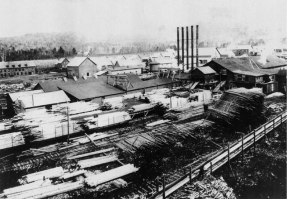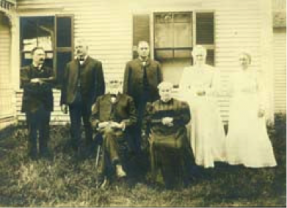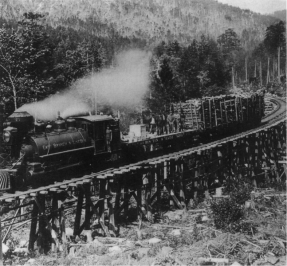History
Lincoln, New Hampshire was established in 1782. The landscape was filled with rivers, mountains, and forests, which made it perfect for logging. Soon after, sawmills began to appear throughout the town and were powered by the rivers.
| Logging was the major source of income for residents. By 1853, the Merrimack River Lumber Company was logging on the East Branch of the Pemigewasset. Several small sawmills were functioning in town. Things changed forever when in 1892, James E. Henry bought thousands of acres of virgin timber and moved his experienced loggers from Zealand. (He had built the town of Zealand, which included a large steam operated sawmill, boarding house, company store, company houses for the workers, a large home for his family, a logging railroad, charcoal kilns and more.) Henry and his men set up operations in the |  |
| area we know today as the Town of Lincoln. J.E. Henry and his family were very good at what they did, and that was turning trees into lumber, and later into paper, for a rapidly expanding national economy. | |
They built the town and one of the longest running logging railroads in the state. They owned the town: mill, school, company store, hospital, jail, boarding house, hotel, and just about everything else in town. Henry family members were Selectmen, Post Masters, Justices of the Peace, etc. As market conditions changed, and technology improved, the Henry’s went into the paper business, and eventually what started out as a sawmill enterprise became a large paper making company. The population was extremely low in this town for about one hundred years until trains began bringing tourists to Lincoln to view the mountains. |
|
The East Branch and Lincoln Railroad, built by James E. Henry, was the largest logging railroad in New England, covering about 72 miles, sidings included. And the railroad lasted far longer than any other logging line in the region. Construction began in 1894 and continued sporadically over a number of years. The last train chugged out of the Lincoln woods in 1948, fifty-four years later. Lincoln village was the site of a large sawmill and later a pulp mill and a paper mill built by James E. Henry. Henry’s efforts created the large municipality of Lincoln, NH, arising from a wilderness home site in the 1890’s. They, and their successors, became the dominant industry in the area and the largest employer. Although, certainly not the only sawmill in the area, they were the largest, and, one way or another, did business with most of the lumberman. |
|
| In addition, many other area businesses derived a part of their income from doing business with the mills and the growing population. J.E. Henry died in 1912, having become a wealthy man. His three sons, who had become active with him in the business, sold the company and the town to the Parker Young Company in 1917, for $3,000,000. (The original Mr. Parker and Mr. Young started out with a starch mill in Lisbon in 1843. But that’s another story). | |




